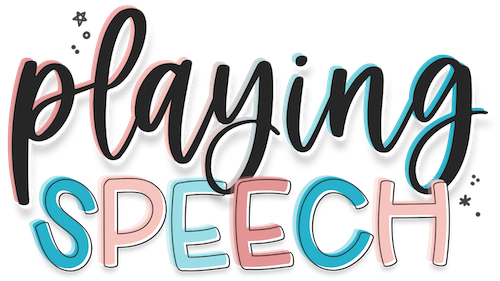Complex Clusters in Speech Therapy: Faster Progress Using the Complexity Approach!
What Are Consonant Clusters?
In English, consonant clusters refer to groups of two or more consonants placed together without vowels. They can be found at the beginning (as in “blow”), middle (as in “basket”), or end (as in “mask”) of words. These clusters are more complex than single consonants, also known as singletons, and their complexity increases with the number of consonants involved. Clusters are an important aspect of phonological development, especially for children with speech sound disorders. In speech therapy, consonant clusters are often targeted in an attempt to quickly improve a child’s speech intelligibility, with careful consideration given to the cluster’s complexity and the child’s current phonemic abilities.
Two-Element Clusters vs. Three-Element Clusters
When discussing consonant clusters in speech therapy, it’s important to differentiate between two-element clusters (e.g., BL in “blue” or ST in “stop”) and three-element clusters (e.g., SPL in “splash” or STR in “street”). When it comes to complexity, two-element clusters are considered less complex than three-element clusters. Both types of clusters are appropriate targets in your speech therapy sessions. However, which type of cluster you choose as your targets depends on the specific child you are working with. Let’s take a more in-depth look at guidelines and rationales for choosing each type of cluster.
Two-Element Clusters: Small Sonority Difference for Better Generalization
When selecting two-element clusters in a complexity approach, it’s best to choose clusters with a small sonority difference, like FL and SL clusters. (To learn more on how to figure out the sonority different of a cluster, check out this freebie here.) Research has shown that teaching children clusters with small sonority differences (e.g., a difference of +3) leads to broader generalization. Children who learn these clusters are more likely to apply their knowledge to clusters with a range of sonority differences, improving overall speech production. On the other hand, when children are taught clusters with a larger sonority difference (such as PL or TW), their learning tends to be more limited to the specific clusters they’ve practiced, showing less generalization to other clusters.
Three-Element Clusters: Considerations for Speech Therapy
Three-element clusters (e.g., SPL, STR, SPR) are the most complex types of consonant clusters in English. While they can be very effective in improving overall speech sound development, incorporating them into speech therapy requires careful consideration.
According to Gierut and Champion (2001), successful intervention using three-element clusters depends on the child’s current phonemic inventory. Specifically, the child should already have the second and third consonants of the cluster already in their repertoire.
For example, let’s consider the SPL cluster. Children who already have the stop (/p/) and the liquid (/l/) in their current repertoire but need to incorporate the /s/ sound into their productions will tend to show greater learning of both untaught true 2-element clusters and even singleton consonants after working on the SPL cluster!
However, the children who already have the /s/ and stop (/p/) of the 3 element cluster SPL in their phonemic inventory only demonstrated learning of untaught two-element adjunct clusters (SP, SK, ST) and nothing else. (Wondering why some clusters are considered adjunct? Check out that freebie here.)
Furthermore, if the child only has one element of the three-element cluster in their inventory, research suggests that there is little to no generalization to other cluster types (neither adjunct nor true clusters). This makes it super important for speech therapists to evaluate a child’s phonemic inventory before deciding to target three-element clusters.
Using Consonant Clusters in Speech Therapy: More Bang for Your Buck!
Consonant clusters are an important area of focus in speech therapy, particularly for children with speech sound disorders. They can lead to significant changes in a child’s overall phonological system when used correctly. While two-element clusters may provide a more accessible starting point, especially when chosen based on sonority differences, three-element clusters can lead to even greater system-wide changed when used properly. By selecting clusters that align with the child’s current abilities and following evidence-based guidelines, speech therapists can help children achieve faster progress! Mastering clusters can improve a child's overall speech intelligibility efficiently and effectively, making them a game-changer when it comes to successful speech therapy interventions.
A Comprehensive Complex Clusters Resource
If you want a comprehensive complex clusters resource that includes flash cards, no prep hands-on activities, and Boom Cards for the 10 most complex clusters in the English language, than you need to check out this resource here! This Complex Clusters Toolkit includes everything you need to start using complex clusters in your speech therapy sessions today!
Designed specifically for the complexity approach, this toolkit will transform your phonological intervention by focusing on the most challenging, later-developing sounds—enabling a quicker, system-wide improvement in speech intelligibility.
What's inside:
Informational handouts to guide you through the complexity approach
100+ stimuli cards covering the 10 most complex 2- and 3-element clusters (SKW, SPL, STR, SKW, SKR, FL, FR, SL, SHR, THR)
50 ready-to-use practice sheets to get high repetitions in-session or for easy homework assignments
Boom Cards version of stimuli cards for quick, no-prep activities
This resource delivers a tried-and-true approach that will change the game for your phonological interventions. We’ve done all the work for you - with quick-start info, comprehensive practice materials, and high-impact cluster choices - so, you’ll be ready to tackle complex speech sounds confidently and see incredible results in your students' progress.
SOURCES:
Storkel, H.L. (2018) The Complexity Approach to Phonological Treatment: How to Select Treatment Targets. Language, Speech, and Hearing Services in Schools, 1–19
Gierut, J. and Champion, A. (2001) Syllable onsets II: three-element clusters in phonological treatment. Journal of speech, language, and hearing research, 44(4), 886–904.



